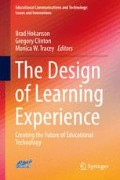Abstract
Learner-centered instructional strategies provide learners with increased autonomy of the learning process and promote participatory learning through solving authentic problems that are contextually relevant to the learners’ environment. Instructors must be adaptable to the needs of their learners and flexible to address the challenges associated with learner-centered instruction. A cognitive apprenticeship was used to teach undergraduate faculty how to develop more contextually relevant learning experiences for their courses. Examples of how such experiences promote principles of situated learning and enhance the design of instruction are discussed.
Access this chapter
Tax calculation will be finalised at checkout
Purchases are for personal use only
References
Brown, J. S., Collins, A., & Duguid, P. (1989). Situated cognition and the culture of learning. Educational Researcher, 18(1), 32–42.
Brush, T., & Saye, J. (2000). Implementation and evaluation of a student-centered learning unit: A case study. ETR&D, 48(3), 79–100.
Chen, T., Chang, C., Lin, J., & Yu, H. (2009). Context-aware writing in ubiquitous learning environments. Research and Practice in Technology Enhanced Learning, 4(1), 61–82.
Collins, A. (1989). Cognitive apprenticeship and instructional technology. Technical report. Cambridge, MA: BBN Labs, Inc.
Collins, A., Brown, J. S., & Newman, S. E. (1989). Cognitive apprenticeship: Teaching the crafts of reading, writing, and mathematics. In L. B. Resnick (Ed.), Knowing, learning, and instruction: Essays in honor of Robert Glaser (pp. 453–494). Hillsdale, NJ: Lawrence Erlbaum.
Collins, A., Hawkins, J., & Carver, S. M. (1991). A cognitive apprenticeship for disadvantaged students. In B. Means, C. Chelemer, & M. S. Knapp (Eds.), Teaching advanced skills to at-risk students: Views from research and practice (pp. 216–243). San Francisco: Josey-Bass.
Doyle, T. (2008). Helping students learn in a learner-centered environment: A guide to facilitating learning in higher education. Sterling, VA: Stylus.
Duncan, S. L. S. (1996). Cognitive apprenticeship in classroom instruction: Implications for instructional and technical teacher education. Journal of Instructional Teacher Education, 33(3), 66–86.
Gibbons, A. S. (2014). Eight views of instructional design and what they should mean to instructional designers. In B. Hokanson & A. Gibbons (Eds.), Design in educational technology: Design thinking, design process, and the design studio (pp. 15–36). New York: Springer.
Herrington, J., & Oliver, R. (2000). An instructional design framework for authentic learning environments. ETR&D, 48(3), 23–48.
Hokanson, B., & Miller, C. (2009). Role-based design: A contemporary framework for innovation and creativity in instructional design. Educational Technology, 49(2), 21–28.
Kahl, H., & Venette, S. (2010). To lecture or let go: A comparative analysis of student speech outlines from teacher-centered and learner-centered classrooms. Communication Teacher, 24(3), 178–186.
Lave, J., & Wenger, E. (1991). Situated learning: Legitimate peripheral participation. Cambridge, UK: Cambridge University Press.
McCombs, B., & Whistler, S. (1997). The learner-centered classroom and school. San Francisco: Jossey Bass.
Richey, R. C., Klein, J. D., & Tracey, M. W. (2011). The instructional design knowledge base: Theory, research, and practice. New York: Routledge.
Smith, K., & Boling, E. (2009). What do we make of design? Design as a concept in educational technology. Educational Technology, 49(4), 3–17.
Stefaniak, J. E. (2013). The use of cognitive apprenticeships to teach learner-centered instructional strategies in an undergraduate learning environment (Doctoral dissertation). Retrieved from Wayne State University Dissertations. Paper 798.
Stefaniak, J., & Baaki, J. (2013). A layered approach to understanding your audience. Performance Improvement, 52(6), 5–10.
Author information
Authors and Affiliations
Corresponding author
Editor information
Editors and Affiliations
Rights and permissions
Copyright information
© 2015 Springer International Publishing Switzerland
About this chapter
Cite this chapter
Stefaniak, J. (2015). Promoting Learner-Centered Instruction Through the Design of Contextually Relevant Experiences. In: Hokanson, B., Clinton, G., Tracey, M. (eds) The Design of Learning Experience. Educational Communications and Technology: Issues and Innovations. Springer, Cham. https://doi.org/10.1007/978-3-319-16504-2_4
Download citation
DOI: https://doi.org/10.1007/978-3-319-16504-2_4
Publisher Name: Springer, Cham
Print ISBN: 978-3-319-16503-5
Online ISBN: 978-3-319-16504-2
eBook Packages: Humanities, Social Sciences and LawEducation (R0)

